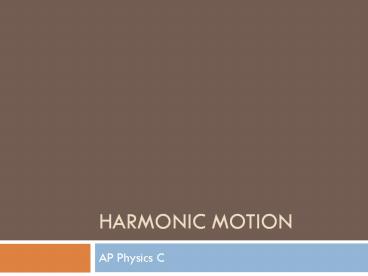Harmonic Motion PowerPoint PPT Presentation
1 / 12
Title: Harmonic Motion
1
Harmonic Motion
- AP Physics C
2
Springs are like Waves and Circles
The amplitude, A, of a wave is the same as the
displacement ,x, of a spring. Both are in meters.
CREST
Equilibrium Line
Period, T, is the time for one revolution or in
the case of springs the time for ONE COMPLETE
oscillation (One crest and trough). Oscillations
could also be called vibrations and cycles. In
the wave above we have 1.75 cycles or waves or
vibrations or oscillations.
Trough
Tssec/cycle. Lets assume that the wave crosses
the equilibrium line in one second intervals. T
3.5 seconds/1.75 cycles. T 2 sec.
3
Frequency
- The FREQUENCY of a wave is the inverse of the
PERIOD. That means that the frequency is the
cycles per sec. The commonly used unit is
HERTZ(HZ).
4
Recall Hookes Law
Here is what we want to do DERIVE AN EXPRESSION
THAT DEFINES THE DISPLACEMENT FROM EQUILIBRIUM OF
THE SPRING IN TERMS OF TIME.
WHAT DOES THIS MEAN? THE SECOND DERIVATIVE OF A
FUNCTION THAT IS ADDED TO A CONSTANT TIMES ITSELF
IS EQUAL TO ZERO. What kind of function will
ALWAYS do this?
5
A SINE FUNCTION!
6
Putting it all together The bottom line
Since all springs exhibit properties of circle
motion we can use these expressions to derive the
formula for the period of a spring.
7
The simple pendulum
If the angle is small, the radian value for
theta and the sine of the theta in degrees will
be equal.
mgcosq
q
mg
mgsinq
A simple pendulum is one where a mass is located
at the end of string. The strings length
represents the radius of a circle and has
negligible mass.
Once again, using our sine function model we can
derive using circular motion equations the
formula for the period of a pendulum.
8
The Physical Pendulum
A physical pendulum is an oscillating body that
rotates according to the location of its center
of mass rather than a simple pendulum where all
the mass is located at the end of a light string.
It is important to understand that d is the
lever arm distance or the distance from the COM
position to the point of rotation. It is also the
same d in the Parallel Axes theorem.
9
Example
- A spring is hanging from the ceiling. You know
that if you elongate the spring by 3.0 meters, it
will take 330 N of force to hold it at that
position The spring is then hung and a 5.0-kg
mass is attached. The system is allowed to reach
equilibrium then displaced an additional 1.5
meters and released. Calculate the
Spring Constant
110 N/m
Angular frequency
4.7 rad/s
10
Example
- A spring is hanging from the ceiling. You know
that if you elongate the spring by 3.0 meters, it
will take 330 N of force to hold it at that
position The spring is then hung and a 5.0-kg
mass is attached. The system is allowed to reach
equilibrium then displaced an additional 1.5
meters and released. Calculate the
Amplitude
Stated in the question as 1.5 m
Frequency and Period
0.75 Hz
1.34 s
11
Example
- A spring is hanging from the ceiling. You know
that if you elongate the spring by 3.0 meters, it
will take 330 N of force to hold it at that
position The spring is then hung and a 5.0-kg
mass is attached. The system is allowed to reach
equilibrium then displaced an additional 1.5
meters and released. Calculate the
Total Energy
123.75 J
Maximum velocity
7.05 m/s
12
Example
A spring is hanging from the ceiling. You know
that if you elongate the spring by 3.0 meters, it
will take 330 N of force to hold it at that
position The spring is then hung and a 5.0-kg
mass is attached. The system is allowed to reach
equilibrium then displaced an additional 1.5
meters and released. Calculate the
Position of mass at maximum velocity
At the equilibrium position
Maximum acceleration of the mass
33.135 m/s/s
Position of mass at maximum acceleration
At maximum amplitude, 1.5 m

